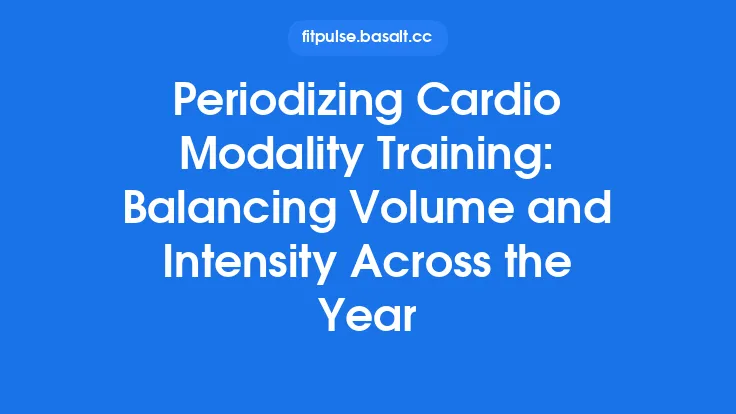The ability to translate a competition calendar into a coherent training plan is the cornerstone of successful seasonal periodization. Coaches and athletes must first understand the rhythm of their sport’s season—when the key meets, qualifiers, championships, and recovery windows occur—and then sculpt training cycles that build the necessary qualities, peak at the right moments, and preserve long‑term health. This article walks through the systematic process of aligning training phases with a competition schedule, offering practical tools, timelines, and monitoring strategies that remain relevant across sports and performance levels.
1. Mapping the Competition Landscape
1.1. Identify Core Events
Begin by listing every competition that will influence training priorities:
| Event Type | Typical Timing | Strategic Importance |
|---|---|---|
| Primary Championship | End of season (e.g., June) | Main performance goal |
| Qualifying Meets | Mid‑season (e.g., March) | Must‑pass standards |
| Minor Meets / Tournaments | Throughout season | Skill refinement, tactical testing |
| Off‑Season / Rest Period | Post‑season (e.g., July–August) | Recovery, mental reset |
Distinguish primary peaks (the events that define the season) from secondary peaks (supporting meets that can be used for testing or fine‑tuning). This hierarchy will dictate how much training load can be allocated to each phase.
1.2. Build a Master Calendar
Plot the events on a visual timeline (e.g., Gantt chart or spreadsheet). Include:
- Competition dates (including travel days)
- Mandatory recovery windows (e.g., 48‑72 h after a high‑intensity meet)
- Training blocks (pre‑competition, competition, transition)
- Testing windows (baseline, mid‑season, pre‑peak)
A master calendar provides a macro‑view that guides the placement of high‑intensity, volume‑heavy, and tapering periods.
2. Defining Seasonal Phases
While the terminology varies across sports, most seasons can be broken into three overarching phases that align with the competition calendar:
2.1. Preparatory Phase (Off‑Season to Early Pre‑Season)
- Goal: Develop foundational capacities (strength, aerobic base, mobility) and address any deficits identified in the previous season.
- Duration: Typically 8–12 weeks, but can be extended for athletes returning from injury or a long layoff.
- Key Characteristics: Higher training volume, moderate intensity, emphasis on technique and movement quality. This is the period where “general” conditioning dominates.
2.2. Competitive Phase (Mid‑Season to Final Peak)
- Goal: Convert the general capacities built earlier into sport‑specific performance, sharpen tactical execution, and peak for primary events.
- Duration: Varies with the number of competition peaks; often 12–20 weeks.
- Key Characteristics: Shift toward higher intensity, lower volume, increased sport‑specific drills, and strategic tapering before each target meet.
2.3. Transition Phase (Post‑Season)
- Goal: Facilitate physiological and psychological recovery while maintaining a minimal level of activity to prevent detraining.
- Duration: 2–4 weeks for active recovery, followed by a true “off‑season” of 4–6 weeks.
- Key Characteristics: Low‑intensity cross‑training, recreational activities, and a focus on mobility, mental refresh, and planning for the next cycle.
3. Aligning Training Variables with Competition Timing
3.1. Volume‑Intensity Trade‑Off
The classic volume‑intensity relationship is the engine of seasonal planning. As the season progresses:
- Early Preparatory: Volume ↑, Intensity moderate.
- Mid‑Season (pre‑peak): Volume ↓, Intensity ↑.
- Taper (1–3 weeks before a primary meet): Volume ↓ dramatically, Intensity maintained or slightly reduced to preserve neuromuscular adaptations.
A practical way to visualize this is the “inverse‑U” curve, where performance potential rises as volume drops and intensity rises, peaks at the taper, then declines if intensity is reduced too much.
3.2. Frequency and Session Structure
Adjust session frequency to match competition load:
| Period | Sessions per week | Typical Session Layout |
|---|---|---|
| Preparatory | 5–6 | Warm‑up → General conditioning → Skill work → Cool‑down |
| Early Competitive | 4–5 | Warm‑up → Sport‑specific high‑intensity → Tactical drills → Recovery |
| Peak Taper | 3–4 | Warm‑up → Low‑volume high‑intensity → Technical refinement → Short cool‑down |
| Transition | 2–3 (active) | Light aerobic → Mobility → Recreational sport |
3.3. Recovery Integration
Recovery is not a static block but a variable woven throughout the season:
- Micro‑recovery: 24‑48 h between high‑intensity sessions, using active recovery, contrast baths, or sleep hygiene.
- Macro‑recovery: Full days off after competition, especially after travel or high‑stress meets.
- Recovery monitoring: Use HRV, resting heart rate, and subjective wellness questionnaires to adjust upcoming loads.
4. Data‑Driven Planning and Monitoring
4.1. Baseline Assessment
Before the preparatory phase, conduct a comprehensive assessment covering:
- Anthropometrics (body composition, limb lengths)
- Physical capacities (maximal strength, aerobic threshold, power output)
- Movement quality (functional movement screen, mobility tests)
- Sport‑specific metrics (e.g., sprint times, lift velocities, technical proficiency scores)
These data points become reference values for tracking progress and informing load adjustments.
4.2. Ongoing Performance Metrics
Select a small set of key performance indicators (KPIs) that reflect the athlete’s primary goals. For a sprinter, KPIs might include 30‑m split times and squat jump height; for a rower, 2,000‑m erg time and peak power. Record these weekly or bi‑weekly to detect trends.
4.3. Load Quantification Tools
- External Load: GPS distance, repetitions, volume (sets × reps × load), or power meters.
- Internal Load: Session RPE, heart rate zones, lactate concentrations.
Combine external and internal metrics to calculate a training impulse (TRIMP) score, which can be summed across weeks to visualize cumulative stress.
4.4. Adaptive Decision‑Making
When KPI trajectories plateau or internal load spikes (e.g., elevated RPE with unchanged external load), consider:
- Deload week: Reduce volume by 30–50 % while maintaining intensity.
- Technical focus: Swap a high‑intensity conditioning session for a skill‑drill day.
- Recovery boost: Add modalities such as compression, massage, or sleep extension.
5. Multi‑Peak Seasons: Managing Repeated Peaking
Some sports (e.g., track & field, swimming, combat sports) require athletes to peak multiple times within a single calendar year. The following framework helps balance repeated peaks:
- Segment the season into “mini‑cycles” each ending with a target competition.
- Allocate a short “recovery block” (5–7 days) after each peak to dissipate fatigue.
- Use “maintenance phases” between peaks where volume is modest and intensity is kept high enough to preserve adaptations.
- Plan a “re‑build block” before the next major peak, gradually increasing volume again.
A practical example: an elite swimmer may have a 4‑week taper for a national meet, followed by a 1‑week active recovery, then a 3‑week maintenance phase, and finally a 5‑week re‑build leading into a world championship taper.
6. Practical Tools for Seasonal Planning
| Tool | Description | How to Use |
|---|---|---|
| Seasonal Planning Spreadsheet | Columns for weeks, training focus, volume, intensity, recovery, competition, testing | Populate with macro‑cycle dates, adjust weekly based on KPI feedback |
| Periodization Software (e.g., TrainingPeaks, Coach’s Eye) | Cloud‑based logging of sessions, automatic TRIMP calculation, athlete‑coach communication | Sync devices, set alerts for load spikes, generate reports for review |
| Visualization Boards | Physical or digital board showing upcoming competitions, training phases, and key milestones | Keep the team aligned, facilitate quick reference during meetings |
| Wellness App (e.g., WHOOP, Oura) | Continuous monitoring of sleep, HRV, strain | Use data to fine‑tune daily training decisions and taper timing |
7. Case Study: Translating a 12‑Month Calendar into a Seasonal Plan
Athlete: Collegiate 400‑m runner
Competition Calendar:
- Indoor season: Jan–Mar (regional meets)
- Outdoor season: Apr–Jun (conference championships, national qualifiers)
- Off‑season: Jul–Oct (recovery, cross‑training)
Step‑by‑Step Planning:
- Map Events: Plot indoor meets (Jan, Feb, Mar), outdoor conference meet (May), national qualifier (Jun).
- Define Phases:
- Transition (Jul–Sep): Light cross‑training, mobility, mental break.
- Preparatory (Oct–Dec): General strength, aerobic base, technique drills.
- Indoor Competitive (Jan–Mar): Emphasize speed endurance, taper for regional meet in early March.
- Transition (mid‑Mar): 1‑week active recovery after indoor season.
- Outdoor Preparatory (Apr): Shift to higher intensity, race‑specific pacing work.
- Peak Taper (late May): Reduce volume, maintain intensity for conference championship.
- Re‑build (early Jun): Brief volume increase to address any deficits before national qualifier.
- Final Taper (mid‑Jun): 5‑day taper for qualifier.
- Monitoring: Weekly 300‑m split times, monthly squat jump, daily HRV. Adjust volume if HRV drops >5 % from baseline.
- Outcome: Athlete peaks twice (indoor regionals, outdoor nationals) while maintaining a balanced training load throughout the year.
8. Common Pitfalls and How to Avoid Them
| Pitfall | Why It Happens | Prevention Strategy |
|---|---|---|
| Over‑loading the preparatory phase | Desire to “make up” for off‑season time | Set a clear volume ceiling (e.g., 10–12 h/week) and schedule regular recovery weeks |
| Neglecting secondary peaks | Focus solely on the primary championship | Treat secondary meets as “testing opportunities” and plan mini‑tapers accordingly |
| Rigid adherence to a preset calendar | Unforeseen schedule changes (e.g., event postponement) | Build flexibility: keep a “buffer week” that can be repurposed for extra recovery or additional load |
| Ignoring individual variability | Assuming all athletes respond identically | Use individualized monitoring (HRV, RPE) to adjust each athlete’s load |
| Insufficient post‑competition recovery | Underestimating the cumulative fatigue of travel and competition stress | Allocate at least 48 h of low‑intensity activity plus a full day off after each meet |
9. Summary Checklist for Seasonal Periodization Planning
- [ ] List all competitions and rank them by importance.
- [ ] Create a visual master calendar with training phases, testing, and recovery windows.
- [ ] Define the three seasonal phases (preparatory, competitive, transition) with target duration and focus.
- [ ] Establish volume‑intensity progression and tapering protocols for each primary peak.
- [ ] Conduct baseline assessments and select sport‑specific KPIs.
- [ ] Implement a monitoring system (external + internal load, wellness metrics).
- [ ] Schedule regular data reviews and be ready to adjust loads.
- [ ] Plan for multi‑peak seasons with mini‑cycles, recovery blocks, and maintenance phases.
- [ ] Use practical tools (spreadsheets, software, visualization boards) to keep the plan organized and transparent.
- [ ] Review after each season to refine the calendar, phase lengths, and monitoring thresholds.
By systematically aligning training cycles with the competition calendar, coaches can ensure that athletes develop the right qualities at the right time, peak when it matters most, and stay healthy throughout the year. This seasonal periodization framework is adaptable to any sport, level, or training philosophy, providing a timeless blueprint for performance‑driven planning.





